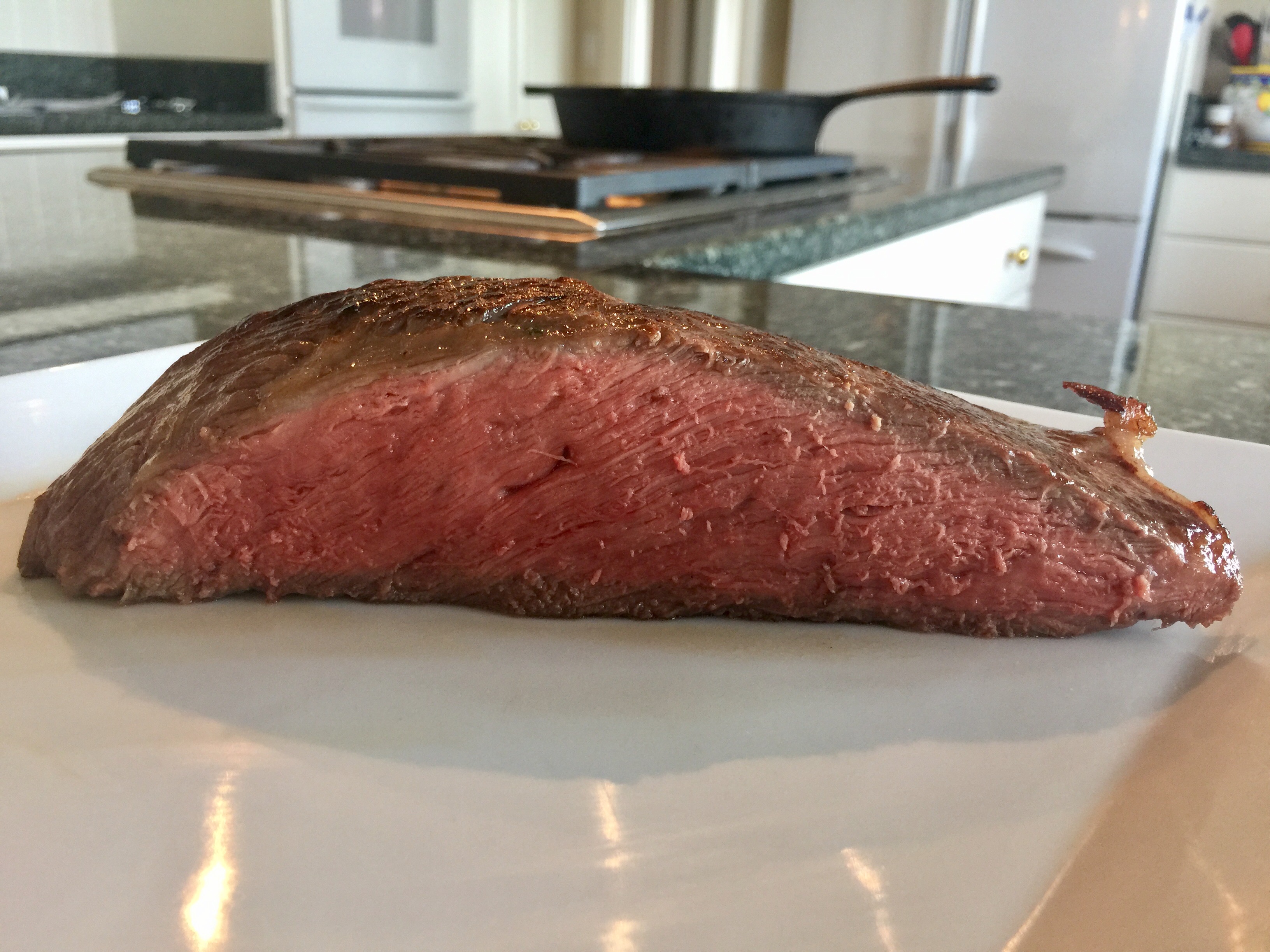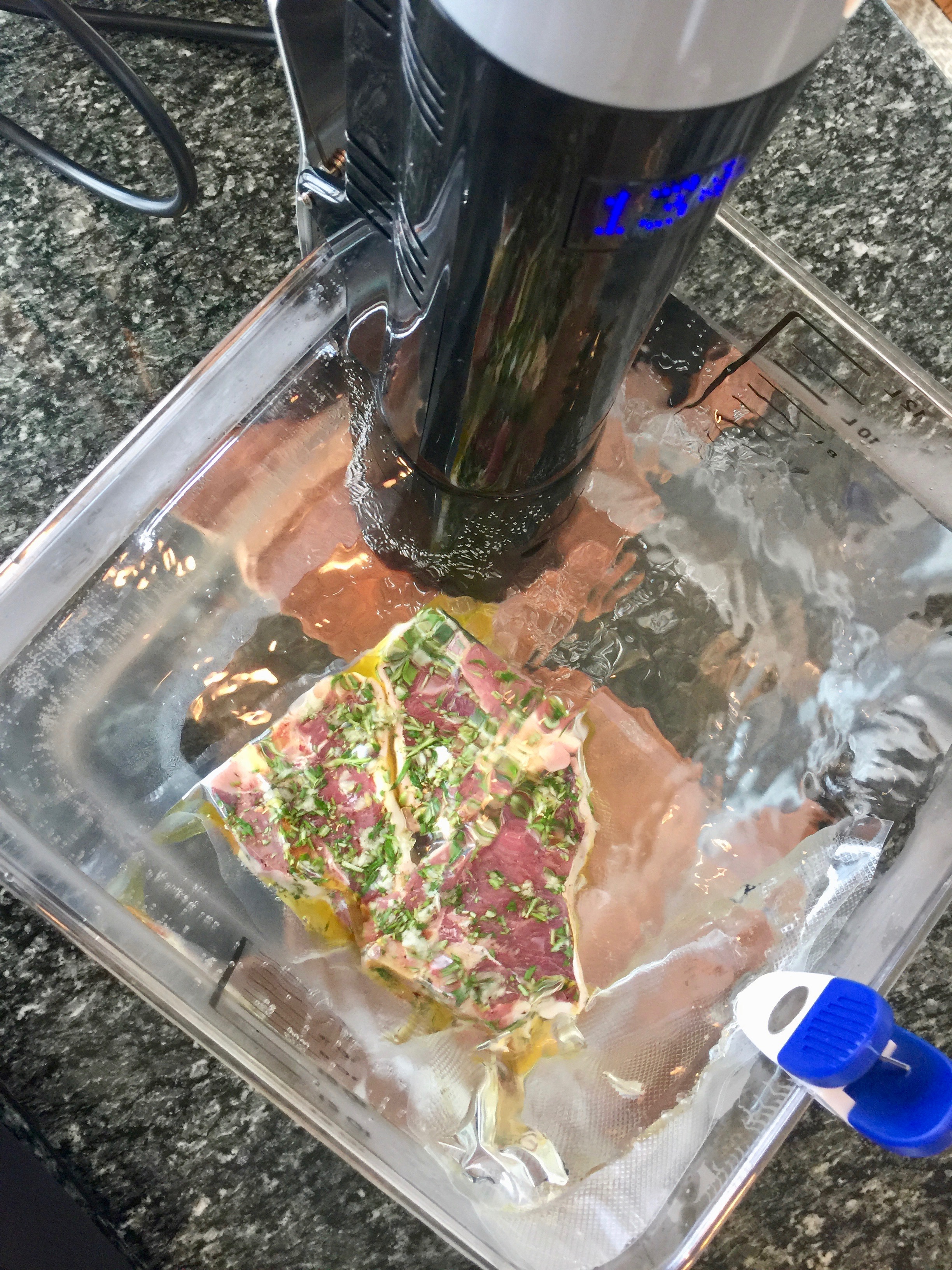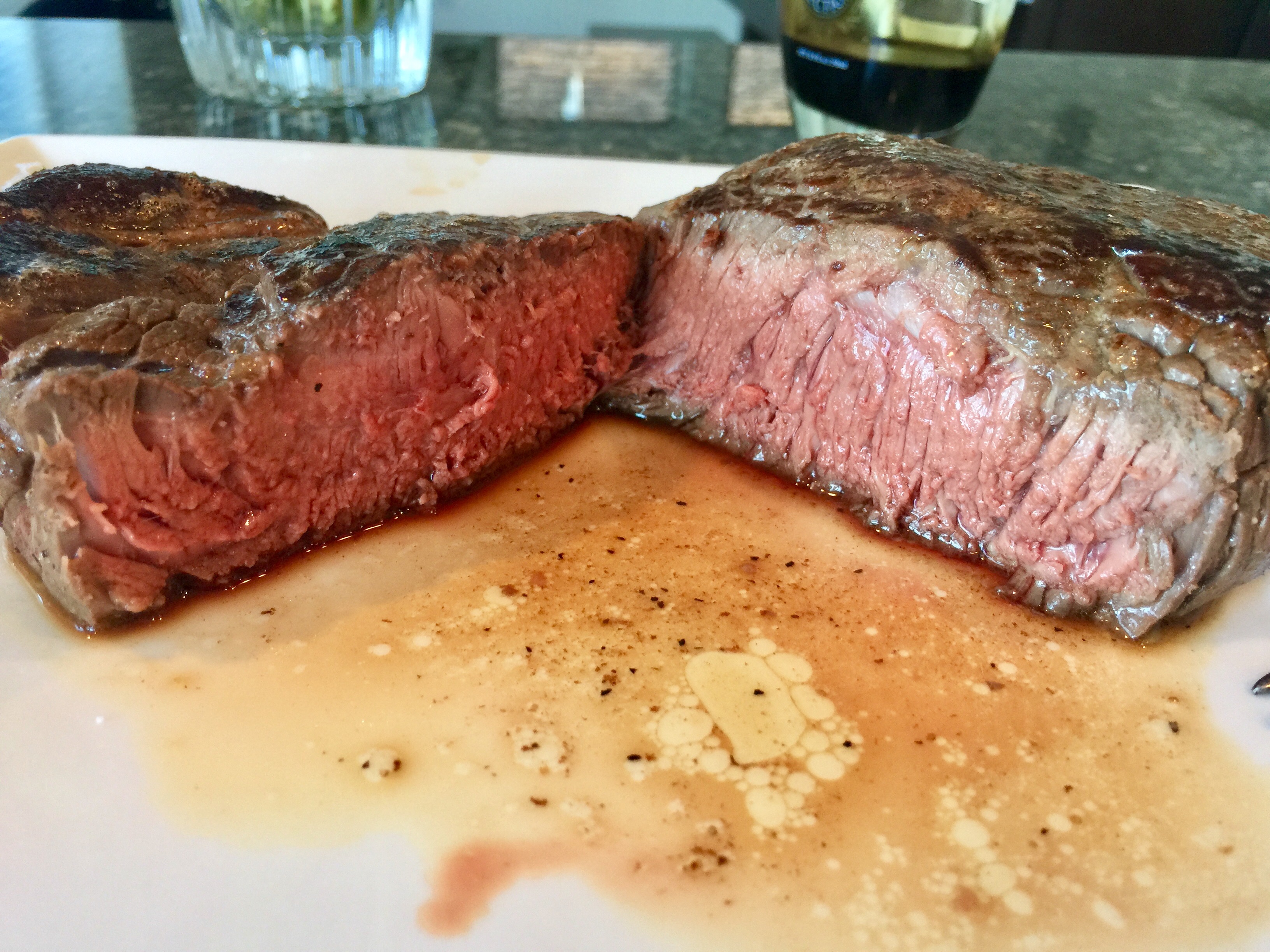 Sous-vide (soo-vide)
Sous-vide (soo-vide)
(French for “under vacuum”) is a method of cooking in which food is sealed in a vacuum-sealed plastic pouch then placed in a temperature-controlled water bath (an accurately regulated temperature much lower than normally used for cooking). The intent is to cook the item evenly, ensuring that the inside is properly cooked without overcooking the outside, and retain moisture.
For years the technique of sous vide was only available to the professional kitchens of restaurants because the cost of an immersion circulator (the tool for cooking sous vide) was enormously expensive and some still are. Smaller and less expensive versions were made for the home chef.
My model is by Sansaire
Available at: Sansaire Store, Amazon, Willimas-Sonoma, Food 52, Target, Bed Bath & Beyond
Ranging in price from $150 Amazon – $200
Go to sansaire.com for additional product and cooking information.
Bare basics needed to cook sous vide include:
– Immersion circulator
– Freezer Zip-lock bag
– Large stock pot
– Item to be sous vide
Extra Sous Vide Equipment (beginners don’t really need these) all available from Amazon
– Large clear plastic food grade tub or container instead of stock pot (cool for seeing through)
– Vacuum sealer
– Sous Vide Water Balls for helping to retain the water heat, best used for long sous vide cooking
– Sous Vide Rack for keeping multiple items in place in the water
The number of things that can be cooked sous vide is endless. Several entertaining articles have been written about just that. Do an internet search for what can be cooked sous vide to find out. The most typical things cooked sous vide are: meat, fish, and eggs.
The idea behind sous vide is to gently cook the item at the precise temperature the item will be eaten. Beef is one of the best examples.
When proteins are removed from the water bath and from the plastic bag, they do not have that classic sear or crust on the outside.
The crust imparts some flavor but is largely a visual and textural component. This is remedied by putting the dried off item in a dry but very hot cast iron skillet or a use culinary blow torch (of which Sansaire also sells) for a quick sear.
The Sansaire website has guideline cooking temperatures and times for beef, fish and eggs. It all depends on how “done” you want the item you are cooking. While ballpark cooking times are given, one of the best things about cooking sous vide, is if you take a nap and you miss the timer going off – don’t worry! The item will never over-cook because the water bath is always kept at a constant precise temperature. The only worry is the water level going down too far from evaporation.
Most immersion circulators have settings for both Celsius and Fahrenheit.
A few options on timing for putting the item to be cooked into the water:
Once the water has reached the proper temp. put the item in.
Put the item in the water and tack on 10-15 extra minutes to allow the water to get to temp.
Start off by adding hot tap water, to cut down on the time it takes to heat the water.
I made a short video on cooking sous vide that you can watch on my website
http://www.labuznik.net

Beef
1
Set-up Your Sansaire
Pick a container that will be large enough to fit your food, with extra room left over for water to circulate. A large soup or stock pot is a great choice. Place your Sansaire inside the pot with the Sansaire’s clip on the outside to hold it steady. Add the water between minimum and maximum fill lines on the Sansaire, and plug in the power cord. Turn it on.
2
How Would You Like Your Steak?
Take your time… this could be the most important decision you’ll make today. Pick the doneness that’s most appealing to you. Go to Sansaire.com for a temperature to doneness guide. The FDA would like to remind you that consuming raw or undercooked meats, poultry, seafood, shellfish, or eggs may increase your risk of foodborne illness.
Cooking Time: One Hour + depending on the cut of meat
I cook beef between 133 – 135 F usually 135 F and get perfectly medium every time.
* The guideline cooking temps. below are from the Sansaire website, but through trial and error you will find your perfect temperature.
Rare – A lot Pink – 50°C OR 122°F
You’re in touch with your inner caveman. Red and juicy.
Medium Rare – Slightly less Pink – 54°C OR 129.2°F
An elegant choice. Cooked just enough to give the steak a gentle firmness, this is the doneness of choice for many meat eaters.
Medium – Just the right amount of Pink – 56°C OR 132.8°F
A superb decision that brings out the best in many steaks, medium steaks have the faintest traces of pinkness remaining.
Well Done – NO Pink – 60°C OR 140°F
Your wish is our command. No judgment… really.
3
Seal Your Steak
Place each steak in a plastic bag or vacuum seal. Zip-lock bags, particularly those labeled as “freezer” bags, are a great choice. You can put more than one steak in each bag – just make sure they don’t overlap each other. Now it’s time to remove the air so your steaks don’t float. Hold the top of the bag open and lower the bottom into to the water bath. The pressure of the water against the bag will force most of the air out. Keep lowering until just the top of the bag is above the water, then zip the top closed and drop it into the water.
4
Cook for 1 Hour. Take a Break.
Your steak will be ready for the next step in an hour. So, this time is all yours. How about a nap? Want to take the dog for a stroll? Maybe catch up on that show you love? Don’t feel guilty for indulging. If anyone asks, you’re making dinner. Oh… and if that hour of indulgent time turns into two or three or four hours, no worries. Your steak will still be just as perfectly cooked when you return to it.
5
Remove and Sear
Using tongs, remove your bags of steak from the bath. Take out the steaks and pat them dry – we’re about to sear them, and wet things don’t like to brown. You can sear with the Sansaire Searing Kit. Light your torch and hold it 3-5” inches from your food, moving in slow passes over the surface until a deep, golden crust develops. Fatty areas may flare up, which adds to the drama (and flavor) of the incredible sear you’re creating.
OR
Dry your steak off top and bottom. Put it in a dry super hot cast iron skillet. Let it sear for 30 sec. to 1 minute and check it. Flip or keep it – depending on your preference. Once on the second side you can get fancy (or not) by adding some aromatics like Thyme and Shallot as well as butter. A Steakhouse trick is to baste the steak once on the second side in butter.

Eggs
Cooking eggs sous vide is a rite of passage. Whereas perfectly poaching an egg is a difficult and noteworthy achievement in traditional cooking, you can perfectly poach a dozen eggs sous vide with your eyes closed. By allowing the eggs to cook slowly over 45 minutes, their texture will become fudgy and silken. You’re about to upgrade your brunch game.
1
Set up your Sansaire – Same as above
2
Pick your perfect Egg
Runny 62°C OR 143.6°F
Just Set 65.5°C OR 149.9°F
Medium Poached 68°C OR 154.4°F
Soft Boiled 73°C OR 163.4°F
3
Add Eggs to the Water Bath
Nature was kind enough to seal eggs inside their own sous vide packaging (the shell!) so it’s not necessary to use bags when cooking whole eggs. Because the water will be hot, and because we don’t want the eggs to crack, lower them gently into the water bath using a spoon.
4
Cook for 45 Minutes
Your eggs will be ready in 45 minutes, so you’ve got some time to kill.
5
Remove, Rinse, & Serve
Using tongs or a slotted spoon, remove the eggs from the bath. Run the shells under cold water for a few seconds until they’re cool enough to handle. Crack the shells gently and decant perfectly cooked sous vide eggs onto the dish of your choice.
Fish
1
Set Up your Sansaire – Same as above
2
Pick the Doneness You Prefer
That’s right, you get to choose how you want your fish cooked. Pick the doneness that’s most appealing to you. Go to Sansaire.com for a temperature to doneness guide.
Very Lightly Cooked – 45°C OR 113°F
Not quite raw, but pretty close. This barely cooked texture is more tender and delicate than sashimi. Not advised for those who can’t eat raw seafood, or for the squeamish.
Lightly Cooked – 50°C OR 122°F
Our favorite for salmon and other fatty fish. Still translucent, briny, and immaculately tender, we think it is perfection.
Medium – 55°C OR 131°F
Firmer and with more body than lower temperatures. A great choice for fish tacos, or if you prefer a more traditional texture.
3
Seal Your Fish – Same as above
4
Cook for 25-30 Minutes
5
Remove & Sear
Using tongs, remove your bags of fish from the bath. Handle them gently, as they’re pretty delicate. If you enjoy a sear on the skin or flesh of your fish the follow the searing directions above. I’ve found it’s not necessary for most fish, but that’s me.
Cooking Sous Vide couldn’t be easier and with foolproof results every time, you may never cook a steak (or animal proteins) the same way again!
Bon Appétit
Leave a comment